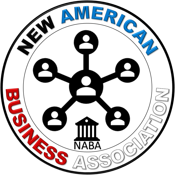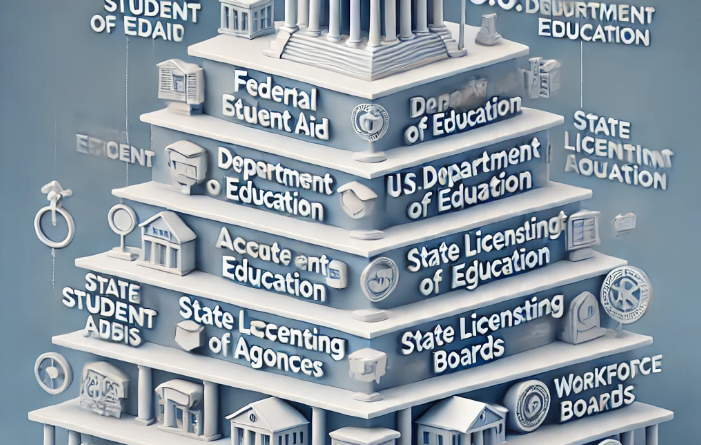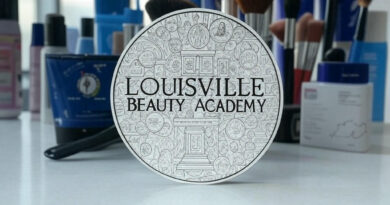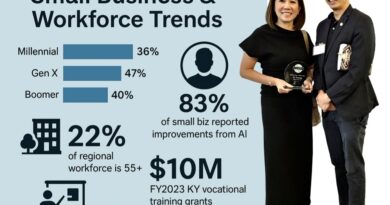The True Cost of Education Access: Understanding Bureaucracy in U.S. Adult & Vocational Schools
An Educational Resource by New American Business Association Inc. (NABA)
Featuring Research and Insight from Louisville Beauty Academy – A Kentucky State-Licensed and State-Accredited Beauty College
Introduction
Access to education in the United States is often championed as a fundamental right—but for those attempting to open or operate an adult education or vocational school, the reality is far more complex. What many don’t see are the layers of bureaucracy that regulate, restrict, and often delay innovative models—especially those that are small, debt-free, and community-driven.
To expose the truth behind these barriers and empower future educators, students, and policymakers, New American Business Association Inc. (NABA), in partnership with Louisville Beauty Academy, presents this in-depth article outlining the full scope of education funding, regulation, and systemic gatekeeping in the U.S.—with a focus on vocational fields such as beauty, wellness, and human services.
Section 1: The Funding Framework – How Federal Money Flows Through Bureaucracy
Category 1: 100% Federally Funded or Nearly So
- Federal Student Loans & Pell Grants
Higher Education Act of 1965, Title IV
Programs like Direct Loans, Pell, and FSEOG are fully federal—but only accessible through accredited, Title IV institutions.
➤ Gatekeepers: U.S. Department of Education, Federal Student Aid, and Accreditors - GI Bill Benefits
Servicemen’s Readjustment Act (1944)
Fully federal but regulated through VA-approved providers. - Federal Work-Study
Funded ~75% federally, requires institutional matching and compliance. - Adult Literacy (WIOA Title II)
~80–100% federal funding but heavily controlled by federal/state alignment.
Category 2: Mixed Federal-State Funding (50–90%)
- IDEA (Special Education)
Only ~15% federal funding despite 40% intent. Highly bureaucratic compliance. - Title I (Low-Income K–12)
100% federal—but only for qualifying schools. Strict rules apply. - CTE / Perkins Funding
Up to 90% federal, but access is controlled by state departments and federal-aligned agencies.
Category 3: Limited Federal Share (5–15%)
- K–12 General Funding
~8–10% federally funded; remainder from state/local taxes.
➤ Still influenced by federal mandates: ESEA, Title IX, etc. - School Nutrition Programs
Administered by USDA, with high operational overhead at local levels. - English Language Acquisition (Title III)
Fully federal but small-scale and tightly regulated.
Category 4: Minimal Federal Support (Under 5%)
- Preschool (Head Start, Grants)
Head Start is 100% federally funded, but most preschool is state/local. - Charter School Grants
Less than 1% of total education funding. Competitive and limited.
Category 5: Zero or Indirect Federal Support
- Private K–12, Homeschooling, For-Profit Colleges
No direct federal funds—except student-level support (loans, Pell)
➤ Ironically, many for-profit institutions rely indirectly on federal dollars through student aid.
Section 2: The Bureaucratic Bottleneck – 12+ Layers of Oversight
Every federally influenced education stream is tied to gatekeepers that act as bottlenecks, delaying innovation, increasing cost, and discouraging small or startup schools. Here’s a breakdown:
- U.S. Congress – Establishes laws like HEA, WIOA, IDEA
- U.S. Department of Education – Interprets and enforces
- Federal Student Aid (FSA) – Title IV eligibility manager
- Accrediting Agencies – Required for funding access
- State Licensing Boards – Legal authority to operate
- State Departments of Education – Local enforcement of federal laws
- Workforce Development Boards – WIOA fund control
- State Fiscal Agencies – Compliance, audits, disbursement
- Local Workforce Boards – Determine approved training providers
- Programmatic Boards (e.g., Cosmetology, Nursing) – Approve curriculum and credentialing
- Reporting Agencies (e.g., IPEDS, Gainful Employment) – Track performance metrics
- Internal Admin Requirements – Schools must hire compliance teams just to stay eligible
Section 3: Why This Blocks Innovation
Despite the good intentions behind regulations, the impact on new, nontraditional, and outcome-driven schools is stark:
- Years of Delay to obtain licensing, accreditation, and approval
- Hundreds of Thousands in Admin Costs before a single student can enroll
- Innovation Stifled – Creative models (short-term, hands-on, cash-based) are often excluded
- Great Schools Shut Out – Like Louisville Beauty Academy, which outperforms many but lacks access to Title IV due to its flexible model
Section 4: Why Louisville Beauty Academy Matters
Louisville Beauty Academy (LBA) is a standout example of what’s possible when schools focus on outcomes, affordability, and compliance at the state level, rather than depending on federal aid. As a state-licensed, state-accredited beauty college, LBA:
- Operates 100% debt-free for students
- Serves multilingual, immigrant, and underserved populations
- Maintains high licensure and placement rates
- Shares transparent, research-driven information to empower others
That’s why NABA proudly recognizes LBA as a national knowledge hub on the regulatory landscape of beauty, wellness, and adult education.
Section 5: What This Means for You
Whether you are:
- A student seeking a better education path
- A founder planning a school
- A donor wanting to support access
- A policymaker evaluating reform
You now have the full picture of how deeply regulated adult education is—and why alternative models like LBA deserve attention, support, and expansion.
Final Word
We hope this article helps demystify the bureaucracy, funding structure, and regulatory burdens facing today’s education system—particularly for adult and vocational programs.
This content was developed for educational purposes only. It reflects public laws, agency guidelines, and firsthand institutional experience. It does not constitute legal advice or policy endorsement. Readers are encouraged to consult appropriate agencies and legal professionals for specific guidance.
💼 Want to support or learn more?
📍 Louisville Beauty Academy
📞 Call/Text: 502-625-5531
📧 Email: study@LouisvilleBeautyAcademy.net
🌐 Visit: www.LouisvilleBeautyAcademy.net
✅ Enroll, Invest, or Donate to empower debt-free, state-compliant, skill-based education.
REFERENCES
📚 Federal Education Funding & Program References
- Higher Education Act of 1965 (Title IV – Federal Student Aid)
🔗 https://www2.ed.gov/policy/highered/leg/hea08/index.html - Federal Student Aid Programs (Loans & Grants Overview)
🔗 https://studentaid.gov/understand-aid/types
🔗 https://studentaid.gov/understand-aid/types/loans
🔗 https://studentaid.gov/understand-aid/types/grants - Federal Work-Study (FWS) Program
🔗 https://studentaid.gov/understand-aid/types/work-study - GI Bill and Veteran Education Benefits
🔗 https://www.va.gov/education/about-gi-bill-benefits/
🔗 https://benefits.va.gov/gibill/ - Workforce Innovation and Opportunity Act (WIOA Title II – Adult Education)
🔗 https://www.law.cornell.edu/uscode/text/29/chapter-32
🔗 https://www2.ed.gov/about/offices/list/ovae/pi/AdultEd/wioa-reauthorization.html - Carl D. Perkins Career and Technical Education Act
🔗 https://cte.ed.gov/legislation/perkins-v - Individuals with Disabilities Education Act (IDEA)
🔗 https://sites.ed.gov/idea/ - Elementary and Secondary Education Act / Every Student Succeeds Act (ESSA)
🔗 https://www.ed.gov/essa - Title I – Education for Low-Income Students
🔗 https://www2.ed.gov/programs/titleiparta/index.html - Title III – English Language Acquisition
🔗 https://www2.ed.gov/programs/sfgp/index.html - National School Lunch Program (NSLP)
🔗 https://www.fns.usda.gov/nslp - Head Start Program (Preschool Funding)
🔗 https://www.acf.hhs.gov/ohs - Charter Schools Program (CSP) – Start-up & Innovation Grants
🔗 https://oese.ed.gov/offices/office-of-discretionary-grants-support-services/charter-school-programs/
🏛️ Agencies & Accrediting Authorities
- U.S. Department of Education
🔗 https://www.ed.gov/ - Federal Student Aid (FSA)
🔗 https://studentaid.gov/ - Council on Occupational Education (COE)
🔗 https://council.org/ - Accrediting Commission of Career Schools and Colleges (ACCSC)
🔗 https://www.accsc.org/ - Kentucky Commission on Proprietary Education (KCPE)
🔗 https://kcpe.ky.gov/ - Kentucky Board of Cosmetology
🔗 https://kboc.ky.gov/ - Office of Career, Technical, and Adult Education (OCTAE)
🔗 https://www2.ed.gov/about/offices/list/ovae/index.html - Integrated Postsecondary Education Data System (IPEDS)
🔗 https://nces.ed.gov/ipeds/ - Gainful Employment Regulations (Archived / Reference)
🔗 https://www2.ed.gov/policy/highered/reg/hearulemaking/2009/gainfulemployment.html - Workforce Development Boards (WIOA Locator)
🔗 https://www.careeronestop.org/LocalHelp/WorkforceDevelopment/find-workforce-development-boards.aspx - State Higher Education Executive Officers Association (SHEEO)
🔗 https://sheeo.org/ - U.S. Department of Veterans Affairs – Education
🔗 https://www.va.gov/education/




